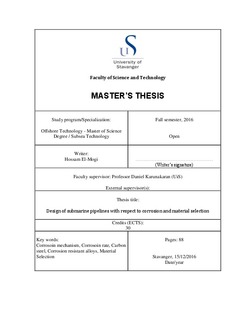| dc.contributor.advisor | Karunakaran, Daniel | |
| dc.contributor.author | El-Mogi, Hossam | |
| dc.date.accessioned | 2017-04-19T12:52:55Z | |
| dc.date.available | 2017-04-19T12:52:55Z | |
| dc.date.issued | 2016-12-15 | |
| dc.identifier.uri | http://hdl.handle.net/11250/2438600 | |
| dc.description | Master's thesis in Offshore technology : subsea technology | nb_NO |
| dc.description.abstract | Pipelines are an essential part of the oil and gas industry as they are the main means of transportation. As the offshore technology advances, subsea pipelines are being operated in more demanding environments. For the pipelines to operate efficiently, they have to be carefully designed. One of the main threats to the integrity of the pipeline is corrosion, which has caused many failures. Corrosion in subsea pipelines has different forms and understanding their mechanisms is an important step in inhibiting them and decreasing their rate of occurrence. As corrosion is unavoidable, it is beneficial to be able to calculate the corrosion rate and the corrosion allowance. By obtaining the results of the corrosion rate it becomes clearer which type of group of steel to consider for the fabrication of the pipeline.
Different types of steels are used in the manufacturing of subsea pipelines. A part of this report focuses on explain the numbering systems and classification of the steels as they are divided into groups and subgroups. The chemical composition is the main character that separates them from each other, which is why the steel types perform differently when introduced to different corrosive environments. Within the commercial steel types, carbon steel is an attractive option to use for subsea pipelines. However, it is not always possible to use it due to the highly corrosive nature of the reservoirs. In that case corrosion resistant alloys are considered, as they posses higher corrosion resistance than conventional steel.
One of the critical stages of pipeline design is the material selection process. Three projects with different parameters are presented as case studies. A simplified process of identifying wether carbon steel and certain corrosion resistant alloys are qualified for use in those projects is demonstrated. The process is based on corrosion rate calculations and continues to compare the different mechanical and corrosion resistance properties of corrosion resistant alloys. | nb_NO |
| dc.language.iso | eng | nb_NO |
| dc.publisher | University of Stavanger, Norway | nb_NO |
| dc.relation.ispartofseries | Masteroppgave/UIS-TN-IKM/2016; | |
| dc.subject | offshore technology | nb_NO |
| dc.subject | offshore teknologi | nb_NO |
| dc.subject | subsea | nb_NO |
| dc.subject | corrosion mechanism | nb_NO |
| dc.subject | corrosion rate | nb_NO |
| dc.subject | korrosjon | nb_NO |
| dc.subject | carbon steel | nb_NO |
| dc.subject | corrosion resistant alloys | nb_NO |
| dc.subject | material selection | nb_NO |
| dc.subject | marin- og undervannsteknologi | nb_NO |
| dc.title | Design of Submarine Pipeline With Respect to Corrosion and Material Selection | nb_NO |
| dc.type | Master thesis | nb_NO |
| dc.subject.nsi | VDP::Teknologi: 500::Marin teknologi: 580::Offshoreteknologi: 581 | nb_NO |
